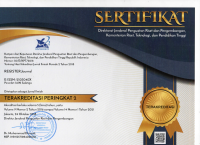Abstract
This study deals with The Fishbowl Method to Improve the Students’ Speaking Skill (An Experimental Study in Ninth Grade Students of SMP N 2 Ambarawa in the Academic Year of 2014/2015). This research was done to answer the objectives of study, namely (1) to find out the difference of lecturing and Fishbowl method in Ninth Grade Students of SMP N 2 Ambarawa in the academic year of 2014/2015, (2) to find out the significant difference of lecturing and Fishbowl method in Ninth Grade Students of SMP N 2 Ambarawa in the academic year of 2014/2015. This research applied descriptive quantitative method. The objects were Ninth Grade Students of SMP N 2 Ambarawa in the academic year of 2014/2015, and the analyzing data were students’ speaking skill that was taught by Fishbowl Method. The sample of this research was taken 28% from population. The numbers of sample were 50 students that were divided into 2 groups. The first group was experimental group and the second group was control group. The data tested using t-test formula by comparing the mean score of pre-test and post-test from both classes. The level of significance was set equal or less than 5%. The result of this study showed that t-value 8, 511 was higher than t-table 2, 064 with the degree of freedom (df) of 24. Therefore, it could be concluded that there was significant difference of T-test between students taught by lecturing and students taught by Fishbowl method. Since t-value was higher than t-table, it meant that null hypothesis was rejected and alternative hypothesis was accepted. Thus, it could be said that Fishbowl method improved students’ speaking skill in Ninth Grade Students of SMP N 2 Ambarawa in the academic year of 2014/2015
Keywords
Fishbowl Method ; speaking ; Students’ Speaking Skills
References
Arikunto, S. (2002). ProsedurPenelitianSuatuPendekatanPraktik. Jakarta :RinekaCipta.
Ary, D..et al. (2007). Introduction to Research in Education. New York: CBS College Publishing.
Barkley, E. F. et al. (2005). Collaborative Learning Techniques: A Handbook for College Faculty . USA: Jossey -Bass.
Brown, H, D. (2000). Teaching by Principles, an Interactive Approach toLanguage Pedagogy. New York: Addison Wesley Longman.
Brown, H, D. (2007) . Prinsip Pembelajaran dan Pengajaran Bahasa. Jakarta: Pearson Education,Inc
Christensen, L.B. (2000). Experimental Methodology. London: Allyn and Bacon Inc.
Hornby, A.S. (1990).Oxford Advanced Learners’ Dictionary
Johnson, B. (2000). Educational Research: Quantitative and Qualitative Approaches. USA: A Pearson Education Company.
Silberman, M. (1996). Active Learning: 101 Strategies to Teach Any Subject. U.K. A Pearson Education Company.
Tarigan, H.G (1990). Berbicara Sebagai Suatu Ketrampilan Berbahasa. Bandung: Angkasa
_____. Fishbowl Method of Instruction.Instructional Technique-Group 4.Retrieved Sunday, 20thJuly 2014, 8:30:49 p.m http://slitoolkit.ohchr.org/data/downloads/fishbowl.pdf










